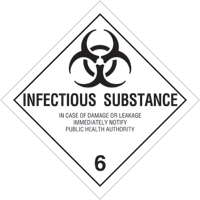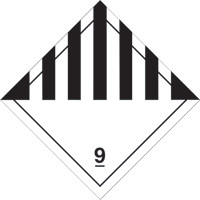On July 20, the Pipeline and Hazardous Materials Safety Administration (PHMSA) published final rule HM-218F, which adopted various amendments to the U.S. Hazardous Materials Regulations in order to update and clarify certain regulatory requirements. By implementing these amendments, PHMSA hopes to:
- promote safer transportation practices;
- eliminate unnecessary regulatory requirements;
- finalize outstanding petitions for rulemaking;
- facilitate international commerce; and
- simplify the regulations.
PHMSA anticipates that the amendments contained in the rule will generate economic benefits to the regulated community. The final rule became effective on August 19.
Among the changes included in HM-218F were several modifications to hazard communication requirements for labels, placards and intermediate bulk containers (IBCs). The following is a summary of these new rules:

Revised Class 6 Label
- Class 6 Labels – Since references to the Centers for Disease Control (CDC) are no longer required on this label, PHMSA has removed all unnecessary text. Existing Class 6 labels may continue to be used until October 1, 2014.
- Class 9 Labels– In order to bring this label more in-line with international standards, PHMSA has revised the Class 9 label specifications by removing the horizontal line running across the label at its midpoint. Existing Class 9 labels may continue to be used until October 1, 2014.

Revised Class 9 Label
An example of the revised Class 9 label has been provided by PHMSA, but the sample does not match the international standard, as the lines in each corner of the label are of differing width than the others. It is unclear at this point whether PHMSA will address this irregularity.
- Placard Size – For international harmonization, PHMSA is authorizing the use of placards measuring at least 250 mm (9.84 inches) on each side. This is smaller than the current standard of 273 mm (10.8 inches) on each side. The Hazardous Materials Regulations will continue to permit the use of the larger placard sizes.
- Intermediate Bulk Containers – For international harmonization, PHMSA is revising §172.336 by adding a new paragraph to indicate that when a bulk packaging is labeled instead of placarded in accordance with §172.514(c), identification numbers may be displayed in accordance with §172.301(a)(1). The new paragraph also allows the use of smaller identification markings when a bulk packaging is labeled instead of placarded. Additionally, PHMSA is revising §172.514(c)(4) to indicate that IBCs which are labeled on two opposite sides, rather than placarded, are authorized to display the proper shipping name and UN number in lieu of displaying the UN number on a placard, orange panel, or white square-on-point configuration.
Labelmaster will incorporate all amendments included within HM-218F in its Early 49 CFR, which is designed for hazmat shippers to stay up-to-date on the most current regulatory updates. While the Early 49 CFR is in the same format as the government release, it includes additional features that make it easier to find important information. The 2011 edition of the Early 49 CFR, scheduled for release next month, is currently available for pre-order.


Pingback: Recent Changes to US Hazard Communication Requirements for Labels, Placards and IBCs | Hazardous Materials | Scoop.it
Pingback: Recent Changes to US Hazard Communication Requirements for Labels, Placards and IBCs | Hazardous Materials | Scoop.it